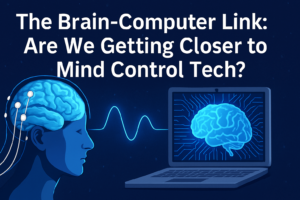Imagine sending a text, moving a cursor, or even controlling a robot — using nothing but your thoughts. It might sound like science fiction, but brain-computer interfaces (BCIs) are quickly becoming a reality thanks to rapid advances in neuroscience and technology.
In early 2024, Neuralink—Elon Musk’s neurotechnology company—made headlines after implanting a brain chip in a human for the first time. The patient, a person with paralysis, could move a computer cursor using only brain signals. This milestone is part of a more significant race to connect the human brain directly to machines.
🧬 How Do Brain-Computer Interfaces Work?
A BCI system allows direct communication between the brain and an external device. Electrodes placed on or inside the brain detect electrical signals produced by neurons. Computer algorithms interpret these signals and turn them into commands—like clicking a mouse, moving a prosthetic limb, or typing words on a screen.
There are non-invasive versions (like EEG headsets) and invasive ones (like brain implants). While non-invasive tools are safer and easier to use, implanted devices offer far more precise and powerful connections.
🤖 Why Is This a Big Deal?
For people with disabilities, BCIs could be life-changing. Stroke victims and individuals with spinal cord injuries could regain control of digital devices, communication tools, or even robotic limbs — all using thought alone.
But the applications go far beyond medicine. Imagine pilots flying aircraft with their minds, artists drawing in 3D space with brain waves, or gamers playing without controllers. BCIs could also lead to new ways to store memory, share thoughts, or enhance human intelligence.
⚠️ But There Are Risks
The possibilities are exciting but also raise serious ethical and safety concerns. Could someone “hack” your thoughts? What happens to privacy when your brain is connected to a network? Could companies monetize brain data like they do with online behavior?
Neuroscientists and ethicists are already debating how to regulate and protect these technologies before they go mainstream.
🔮 What’s Next?
Right now, BCIs are still in the early stages. But progress is accelerating. Companies like Neuralink, Synchron, and Blackrock Neurotech are working on smaller, safer, and more intelligent devices. Researchers are also developing wireless, AI-powered chips that could decode thoughts more accurately than ever.
Whether it’s helping the disabled or pushing the limits of human potential, one thing is clear: the gap between mind and machine is closing — and fast.
